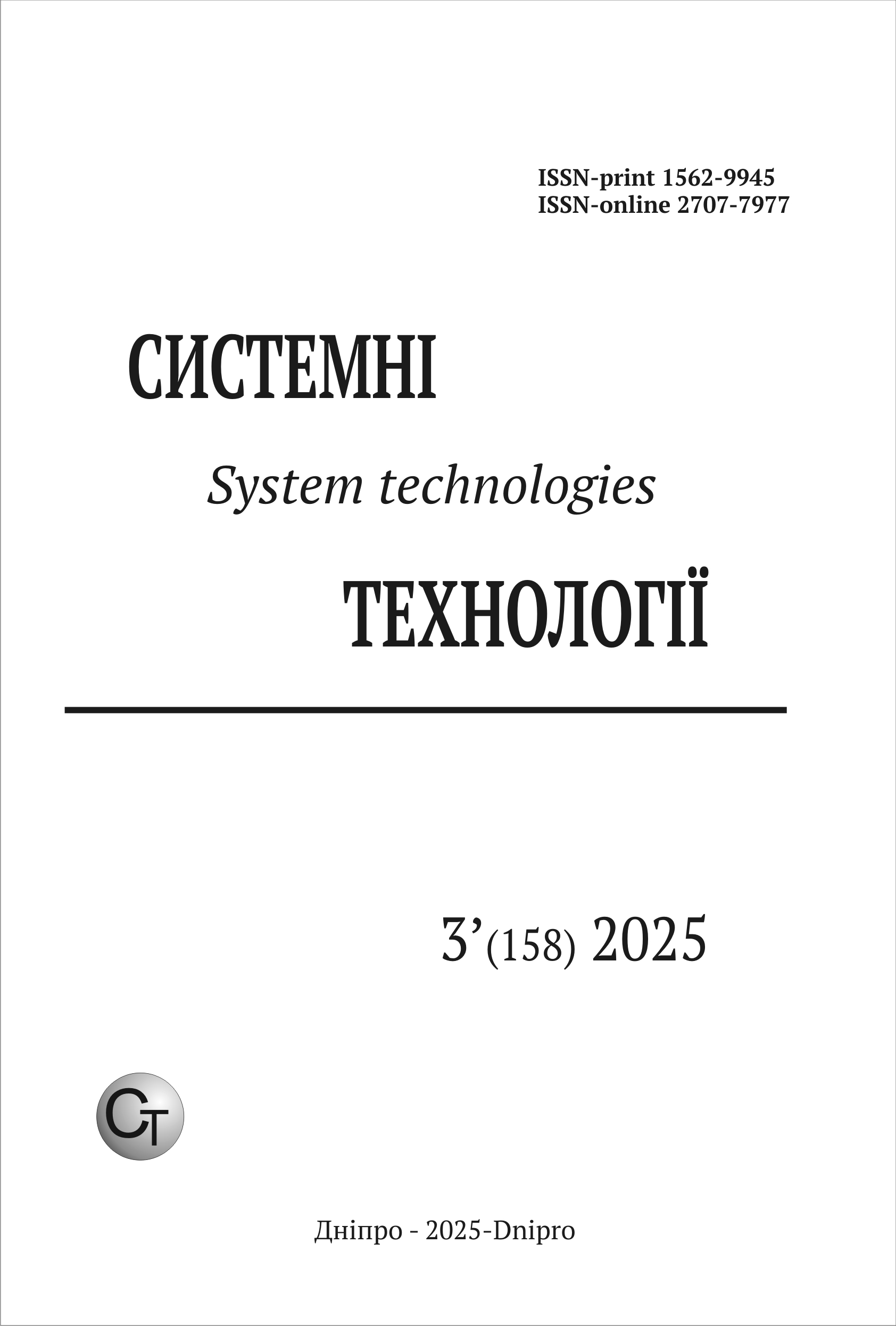СИСТЕМНИЙ ПІДХІД ДО ПРОГНОЗУВАННЯ ПОПИТУ НА ЕЛЕКТРОЕНЕРГІЮ НА ОСНОВІ МАШИННОГО НАВЧАННЯ
DOI:
https://doi.org/10.34185/1562-9945-3-158-2025-05Ключові слова:
Прогнозування, Попит на електроенергію в Україні, Методи машинного навчання, Обробка даних, Методика прогнозування, ARIMA, GAM, ANN, BSTSАнотація
У статті досліджено системний підхід до вирішення проблеми прогнозування попиту на електроенергію в Україні на основі методів машинного навчання. Представлено послідовність етапів обробки даних при розв’язанні задачі прогнозування методами машинного навчання. Розглянуто методологію вирішення задачі прогнозування на часових рядах. Процес прогнозування складається з п'яти етапів. Перший етап включає збір, аналіз та інтерпретацію даних. Наступний етап включає процедури дослідження та підготовки даних. Третій етап - етап моделювання складається з трьох частин: підготовка набору даних для моделювання, вибір і навчання моделей і оцінка їх якості. Четвертий етап – етап прогнозування та розрахунок якісних показ-ників прогнозів. На п'ятому етапі виконуються процедури підвищення ефективності обраної моделі прогнозування. На етапі моделювання використовувалися такі моделі: ARIMA, GAM, ANN і BSTS. Проведено аналіз моделей і на основі кожної моделі побудо-вано прогнози. Для побудованих моделей з найкращими показниками якості розрахова-но прогнозні значення. Прогнози порівнювали з даними валідаційної вибірки. Для вибору оптимальної моделі використовували такі показники: MAPE, MAE, MSE, RMSE. Най-кращі результати показала модель BSTS.
Посилання
M. R. Kazemzadeh, A. Amjadian, T. Amraee. A hybrid data mining driven algorithm for long term electric peak load and energy demand forecasting. Energy 2020, 204, 117948.
J. Hao, X. Sun, Q. Feng. A Novel Ensemble Approach for the Forecasting of Energy Demand Based on the Artificial Bee Colony Algorithm. Energies 2020, 13, 550.
J. del Real, F. Dorado, J. Durán. Energy Demand Forecasting Using Deep Learning: Applications for the French Grid. Energies 2020, 13, 2242.
J. Bedi, D. Toshniwal. Deep learning framework to forecast electricity demand. Appl. Energy 2019, 238, pp. 1312–1326.
F. Kaytez. A hybrid approach based on autoregressive integrated moving average and least-square support vector machine for long-term forecasting of net electricity consumption. Energy 2020, 197, 117200.
S. Di Leo, P. Caramuta, P. Curci, C. Cosmi. Regression analysis for energy demand projection: An application to TIMES-Basilicata and TIMES-Italy energy models. Energy 2020, 196, 117058.
P. Ramsami, R. T. A. King. Neural Network Frameworks for Electricity Forecasting in Mauritius and Rodrigues Islands. In Proceedings of the 2021 IEEE PES/IAS PowerAfrica, Nairobi, Kenya, 2021, pp. 1–5.
D. Angelopoulos, Y. Siskos, J. Psarras. Disaggregating time series on multiple criteria for robust forecasting: The case of long-term electricity demand in Greece. Eur. J. Oper. Res. 2019, 275, pp. 252–265.
U. Şahin, S. Ballı, Y. Chen. Forecasting seasonal electricity generation in European countries under COVID-19-induced lockdown using fractional grey prediction models and machine learning methods. Appl. Energy 2021, 302, 117540.
R. Hou, S. Li, M. Wu, G. Ren, W. Gao, M. Khayatnezhad. Assessing of impact climate parameters on the gap between hydropower supply and electricity demand by RCPs scenarios and optimized ANN by the improved Pathfinder (IPF) algorithm. Energy 2021, 237, 121621.
Baba. Advanced AI-based techniques to predict daily energy consumption: A case study. Expert Syst. Appl. 2021, 184, 115508.
M. Pegalajar, L.G. B. Ruíz, M. P. Cuéllar, R. Rueda. Analysis and enhanced prediction of the Spanish Electricity Network through Big Data and Machine Learning techniques. Int. J. Approx. Reason. 2021, 133, pp. 48–59.
N. M. M. Bendaoud, N. Farah, S. Ben Ahmed. Applying load profiles propagation to machine learning based electrical energy forecasting. Electr. Power Syst. Res. 2022, 203, 107635.
R. Porteiro, L. Hernández-Callejo, S. Nesmachnow. Electricity demand forecasting in industrial and residential facilities using ensemble machine learning. Rev. Fac. De Ing. 2022, 102, pp. 9–25.
Y. Lu, G. Wang. A load forecasting model based on support vector regression with whale optimization algorithm. Multimed. Tools Appl. 2023, 82, pp. 9939–9959.
S. Li, X. Kong, L. Yue, C. Liu, M. A. Khan, Z. Yang, H. Zhang. Short-Term Electrical Load Forecasting Using Hybrid Model of Manta Ray Foraging Optimization and Support Vector Regression. J. Clean. Prod. 2023, 388, 135856.
J. Huang, M. Algahtani, S. Kaewunruen. Energy Forecasting in a Public Building: A Benchmarking Analysis on Long Short-Term Memory (LSTM), Support Vector Regression (SVR), and Extreme Gradient Boosting (XGBoost) Networks. Appl. Sci. 2022, 12, 9788.
C. E. Velasquez, M. Zocatelli, F. B. Estanislau, V. F. Castro. Analysis of time series models for Brazilian electricity demand forecasting. Energy 2022, 247, 123483.
F. Pallonetto, C. Jin, E. Mangina. Forecast electricity demand in commercial building with machine learning models to enable demand response programs. Energy AI 2022, 7, 100121.
E. C. May, A. Bassam, L. J. Ricalde, M. E. Soberanis, O. Oubram, O. M. Tzuc, A. Y. Alanis, A. Livas-García. Global sensitivity analysis for a real-time electricity market forecast by a machine learning approach: A case study of Mexico. Int. J. Electr. Power Energy Syst. 2022, 135, 107505.
W. J. Niu, Z. K. Feng, S. S. Li, H. J. Wu, J. Y. Wang. Short-term electricity load time series prediction by machine learning model via feature selection and parameter optimization using hybrid cooperation search algorithm. Environ. Res. Lett. 2021, 16, 055032.
R. Luzia, L. Rubio, C. E. Velasquez. Sensitivity analysis for forecasting Brazilian electricity demand using artificial neural networks and hybrid models based on Autoregressive Integrated Moving Average. Energy 2023, 274, 127365.
Energy Map. URL: https://map.ua-energy.org/uk/resources/5a616fba-fbc9-4073-9532-9161592faca8/
P. Bidyuk, I. Kalinina, A. Gozhyj. An Approach to Identifying and Filling Data Gaps in Machine Learning Procedures. Lecture Notes on Data Engineering and Communications Technologies (Switzeland). 2022. Vol. 77, pp. 164-176.
R. J. Hyndman, G. Athanasopoulos. Forecasting: Principles and Practice 3rd ed. Edition. Publisher: OTexts. 2021, 442 p.
T. Aggarwal. Master the Power of Seasonal Decomposition of Time Series (STL): Unveiling the Essence of Time. 2023. URL: https://medium.com/@tushar_aggarwal/master-the-power-of-seasonal-decomposition-of-time-series-stl-unveiling-the-essence-of-time-26c19a910314
Kalinina., P. Bidyuk., A. Gozhyj, P. Malchenko. Combining Forecasts Based on Time Series Models in Machine Learning Tasks. CEUR-WS. 2023. Vol. 3426. Pp. 25-35. CEUR-WS.org/Vol-3426/paper2.pdf.
Kalinina, P. Bidyuk, A. Gozhyj. Construction of Forecast Models based on Bayesian Structural Time Series. International Scientific and Technical Conference on Computer Sciences and Information Technologies. CSIT_2022. 2022. Pp. 180-184. doi: 10.1109/CSIT56902.2022.10000484.
Завантаження
Опубліковано
Номер
Розділ
Ліцензія
Авторське право (c) 2025 Системні технології

Ця робота ліцензується відповідно до ліцензії Creative Commons Attribution 4.0 International License.















